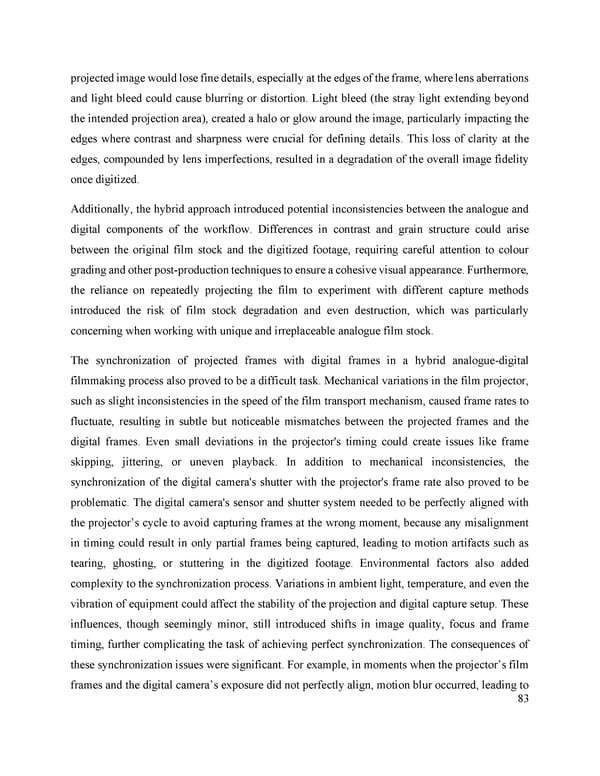projected image would lose fine details, especially at the edges of the frame, where lens aberrations and light bleed could cause blurring or distortion. Light bleed (the stray light extending beyond the intended projection area), created a halo or glow around the image, particularly impacting the edges where contrast and sharpness were crucial for defining details. This loss of clarity at the edges, compounded by lens imperfections, resulted in a degradation of the overall image fidelity once digitized. Additionally, the hybrid approach introduced potential inconsistencies between the analogue and digital components of the workflow. Differences in contrast and grain structure could arise between the original film stock and the digitized footage, requiring careful attention to colour grading and other post-production techniques to ensure a cohesive visual appearance. Furthermore, the reliance on repeatedly projecting the film to experiment with different capture methods introduced the risk of film stock degradation and even destruction, which was particularly concerning when working with unique and irreplaceable analogue film stock. The synchronization of projected frames with digital frames in a hybrid analogue-digital filmmaking process also proved to be a difficult task. Mechanical variations in the film projector, such as slight inconsistencies in the speed of the film transport mechanism, caused frame rates to fluctuate, resulting in subtle but noticeable mismatches between the projected frames and the digital frames. Even small deviations in the projector's timing could create issues like frame skipping, jittering, or uneven playback. In addition to mechanical inconsistencies, the synchronization of the digital camera's shutter with the projector's frame rate also proved to be problematic. The digital camera's sensor and shutter system needed to be perfectly aligned with the projector’s cycle to avoid capturing frames at the wrong moment, because any misalignment in timing could result in only partial frames being captured, leading to motion artifacts such as tearing, ghosting, or stuttering in the digitized footage. Environmental factors also added complexity to the synchronization process. Variations in ambient light, temperature, and even the vibration of equipment could affect the stability of the projection and digital capture setup. These influences, though seemingly minor, still introduced shifts in image quality, focus and frame timing, further complicating the task of achieving perfect synchronization. The consequences of these synchronization issues were significant. For example, in moments when the projector’s film frames and the digital camera’s exposure did not perfectly align, motion blur occurred, leading to 83
 Lost Analogue: Exploring Film, Music, and Interdisciplinary Methods in Education Page 83 Page 85
Lost Analogue: Exploring Film, Music, and Interdisciplinary Methods in Education Page 83 Page 85